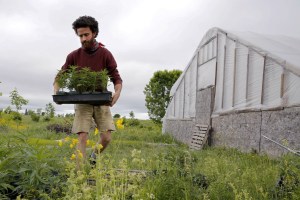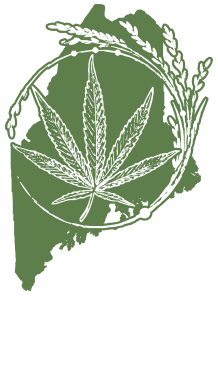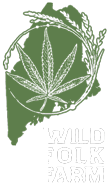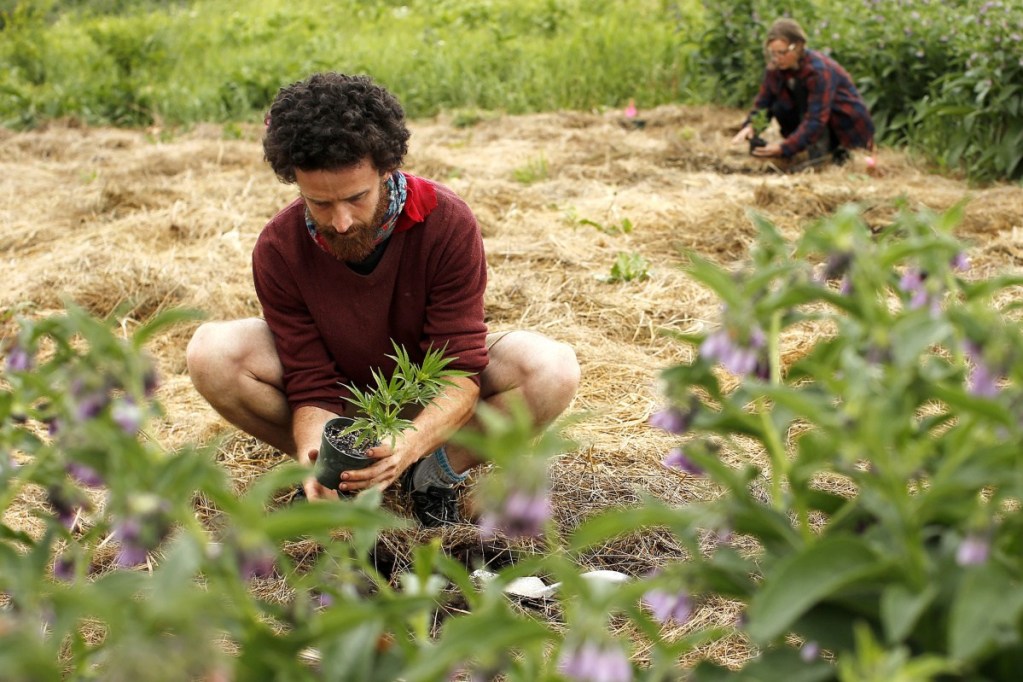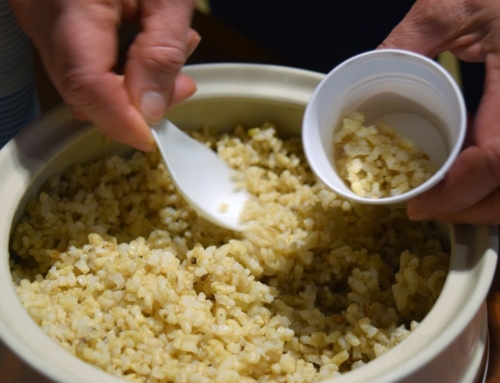In Maine, Industrial Hemp is the Crop to Watch
June 24, 2018 | Mary Pols | Staff Writer | (c) Portland Press Herald
Farmer Ben Rooney spent several days last week rushing around Wild Folk Farm in Benton planting 300 seedlings of Maine’s trendiest new crop, industrial hemp. “We’re kind of in the heat of it now,” he said.
It’s an apt expression; hemp is Maine’s hot new crop after nearly a century of falling by the wayside. The kind of cannabis sativa that doesn’t get you high was once a commonplace crop in New England and throughout America, used to make everything from clothing to rope. Thomas Jefferson and George Washington both grew it. Until 1933, the U.S. Department of Agriculture helpfully developed new varieties of it for farmers.
Two varieties, one species
Confused about the difference between hemp and marijuana? You are not alone. Here is what the plants have in common, and what they don’t:
SAME SPECIES: Both hemp, often referred to as industrial hemp, and marijuana belong to the species Cannabis sativa 1. But they are different varieties.
THEY VARY HOW? Both contain hundreds of chemical compounds known as cannabinoids. Marijuana contains high levels of a cannabinoid called tetrahydrocannabinol, commonly known as THC; hemp contains barely any.
HOW MUCH IS HIGH? Marijuana can contain as much 20 percent THC, or as little as 4 percent. Hemp has less than one percent THC. In Maine, as in the rest of the United States, hemp must have less than .03 percent or it is not considered legal.
SO WHAT IS THE POINT OF HEMP? Hemp has a lot going for it. It’s strong enough to make rope out of (seriously!) and as a food, it is high in protein, particularly fatty, healthy proteins. A hemp heart, which has no psychoactive ingredients, is not so different from chia seeds, according to Gary Fish, Maine’s state horticulturist.
Hemp (and marijuana) also contains a cannabinoid called cannabidiol, usually called CBD, which acts on the body in various helpful ways without the THC high. Non governmental research has shown CBD to have analgesic, anti-inflammatory, and anti-anxiety effects on the body, but the U.S. Food & Drug Administration has not weighed in medical uses for marijuana because it handles approval of legally manufactured drugs only. However, the FDA has approved three drugs made with synthetic cannabinoids (including THC) only. The FDA’s website, fda.gov, has a lengthy Q&A about medical uses of marijuana.
WHY ARE THE NAMES SO SIMILAR? It is a nightmare, we agree. Focus on this: Both CBD and THC are cannabinoids. The first is used for wellness, the second is used primarily to get high.
TOTALLY LEGAL? Yes and no. In Maine, you can grow hemp, as much as you like, as long as you’re licensed and working with varieties that contain THC levels of .03 percent or less. Medical caregivers can grow marijuana, but there are limits on how many plants. The state is still wrestling with administering voter-approved legality of recreational marijuana.
Then hemp began to slip into the shadows, nudged out of production by both the advent of cheap cotton and a federal noose tightening on a plant it considered too closely related to the kind of cannabis sativa that contains high levels of tetrahydrocannabinol, commonly known as THC. Hemp and marijuana are different varieties of cannabis sativa L, and industrial hemp has less than 1 percent THC, compared to the 4 to 20 percent typically contained in marijuana.
Nonetheless, it was lumped together with the plant that make you want to eat potato chips and have a good laugh, and after being deemed illegal, industrial hemp essentially vanished from American farms.
Although Republican Senate Majority Leader Mitch McConnell, whose home state, Kentucky, is at the forefront of hemp cultivation, aims to make it legal nationwide, that hasn’t happened yet. In the meantime, it has been up to states to enact legislation legalizing its cultivation, either for research purposes at a minimum, or commercially. Nineteen have done so, including Maine, where the Legislature approved it as a commercial crop in a 2015 vote. (The state laws that govern its sister plant, marijuana, are entirely separate.)
The next year, Maine’s Department of Agriculture, Conservation and Forestry began issuing licenses for hemp production. In that first growing season in 2016, just two farmers signed up to dip their toes in these still somewhat confusing waters – hemp looks so much like marijuana that growing it means you might find a police officer taking a sudden interest in your fields. In 2016, ultimately only a quarter-acre of licensed hemp was grown in Maine.
Since then the number of Maine farmers growing industrial hemp has surged dramatically, nearly tripling since last year, outpacing even the national trend. According to the hemp advocacy group Vote Hemp, the number of acres of hemp grown across those 19 states more than doubled in 2017, up to a total of 23,343 acres. In Maine, state horticulturist Gary Fish, who oversees the hemp program for the Department of Agriculture, Conservation and Forestry, said at least 888 acres will likely be in hemp production in Maine this summer.
For context, in the most recent Farm Census conducted by the U.S. Department of Agriculture in 2012, Maine had 342 acres in strawberry production and 642 acres of pumpkins.
Rooney, entering his second growing season, is one of 80 farmers growing it in the state. His hemp is a rarity, certified “clean” by the Maine Organic Farmers and Gardeners Association. That’s the closest hemp can get to organic, since it’s the federal government that sets standards for organic, and it still considers the crop illegal. Rooney’s aim is to bring it to the health- and natural-foods markets, a goal Fish says is likely the norm for Maine farmers.
Rooney will use those plants mainly to make tinctures and salves from the plants’ natural cannabidiol – typically known as CBD – to be sold at health-food stores around the state. CBD works on the endocannabinoid system, and proponents say it can have positive impacts on sleep and hormone regulation, as well as soothe pain. CBD products might turn up in a smoothie at Nectar in Bridgton or at Morning Glory in Brunswick in a protein/CBD bar called a “Martha bar” made by Martha Carton. While CBD products with trace amounts of THC are not technically legal from a federal perspective, at health-food stores, no one is enforcing what many consider to be a wildly outdated law. It is, after all, as legal to grow hemp in the state of Maine as a pumpkin. And, many would say, just as healthy.
AIMING TO ‘FEEL OK’
“I feel like the FDA (Food and Drug Administration) is going to have to give it up,” said Kelly Benson of Mindful Earth Wellness. She is one of the state’s newest licensed hemp farmers, although her operation in Raymond is very small, just 30 plants mixed in with a full array of medicinal herbs like chamomile and valerian. “It is really, really ridiculous that they consider it a Schedule 1 drug … they are going to lose this fight.”
Schedule 1 drug refers to the ranking given to drugs based on their potential for abuse and their proven medical value. Other drugs in the same category include heroin. Cocaine is a Schedule 2 drug. Benson was once addicted to heroin, and abused opiates, including oxycodone, for six years. Medicinal herbs like lemon balm helped her in her transition away from opiates.
“The last time I went into rehab was 2010,” Benson said.
Her husband is a medicinal marijuana caregiver and grows plants for his patients. Benson has used medicinal marijuana, but for her, the beauty of the hemp products she began trying about two years ago is the lack of a high.
“I use the oil two times a day normally if I am having a particularly bad day with my anxiety,” she said. “No one wants to feel high. They just want to feel OK.”
Last year she bought hemp from Wild Folk Farm and used it to make her own pain salves for topical use. The 30 plants she’s growing this year are an experiment. “I am just seeing if I like it and enjoy it and then next year, if I do, I will do an acre,” Benson said.
Other farm operations are substantially bigger. Fish said the Canadian company Future Farm has 106 acres licensed to grow in three locations (a Future Farm spokesman did not return calls for comment). Another company has 114 total acres, Fish said. The hemp farms are widely distributed across the state, he said, with no particular region being the focus of hemp farming.
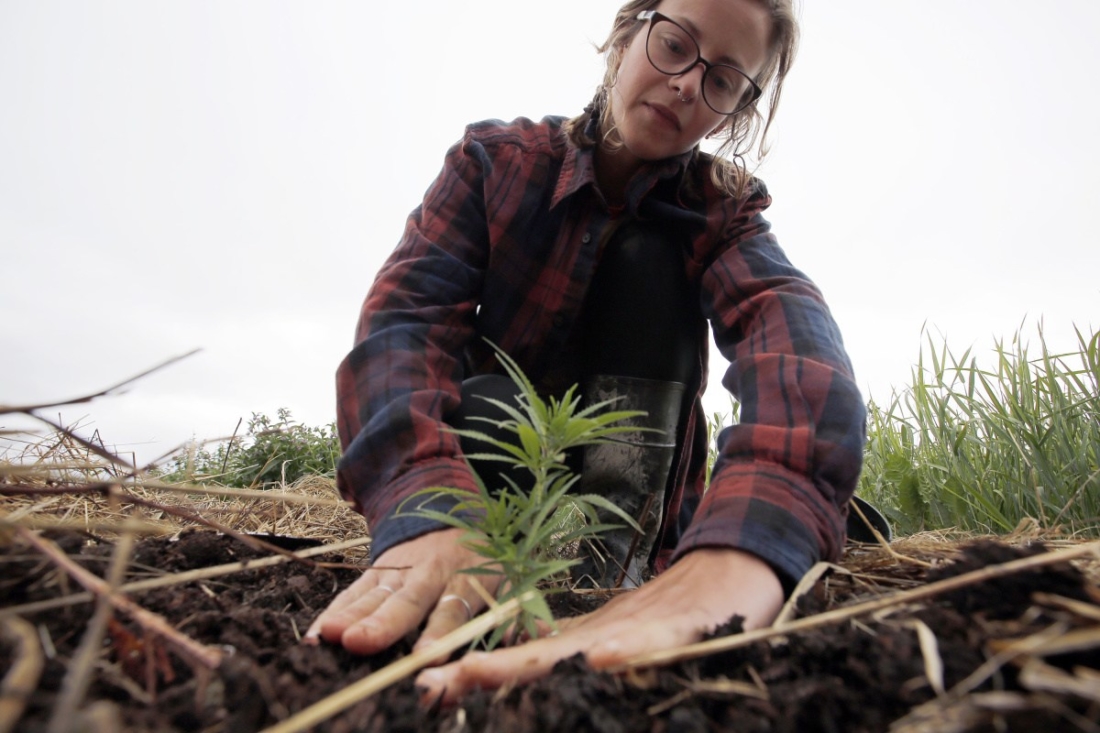
HANDS-ON HEMP
Only outdoor hemp farming is allowed, which Fish said his predecessor in the position of state horticulturist, Ann Gibbs, had advised the Legislature would be wise based on feedback from other states that already allow hemp farming. “Because of warnings from other states that they found they were having problems with growers saying ‘this is industrial hemp’ and then finding that it was way above (the acceptable level of) .3 THC,” Fish said. “They were kind of getting the switcheroo.”
Should indoor cultivation be allowed in the future, Fish said, the number of harvests per year could go from one to as many as three.
In the meantime, farmers work with the weather.
“This spring has been a bugger for many people,” Fish said. That is, too cold, particularly in northern Aroostook County. “They have been planting much later.”
Research into hemp as a viable crop in Maine dates back more than a decade. In 2003, the Maine Agricultural and Forest Experiment Station studied hemp’s potential after the Legislature approved research into the crop. That study concluded that the crop would grow adequately in Maine, with the possible exception of far northern reaches of the state, where the short growing season suggested the exact seasonal limitations some of the Aroostook County farmers are now encountering.
The study cited research that hemp could have as many as 25,000 applications, ranging from clothing to paper products (such as tea bags) and as a component of construction, including thermal insulation.
It also deemed hemp an “environmentally friendly” crop for a number of reasons. Hemp doesn’t need pesticides. It increases organic soil content and water retention, and it reduces erosion. It also suppresses or eliminates weeds. Or in theory it does: “I would say, having seen the majority of all the hemp fields in Maine in the last two years, that almost all of them had terrible weed problems,” Fish said. “Lambs quarters, pigweed, ragweed.”
Part of Fish’s job has been working with law enforcement to make sure both state police and sheriffs know exactly where these hemp farms are. The reason? Hemp looks so much like marijuana. And it is an imposing, dramatic crop. If it is being grown for fiber or grain (namely hemp hearts, which Fish said come primarily from Canada and contain neither THC nor CBD), it’s generally planted in narrow rows, where it grows tall and thin.
For CBD production, Fish said, the style is to give it lots of room to get bushy.
“And the plants look more like Christmas trees,” he said.
Fish said last year, when there were 31 licensed hemp growers in the state, there were two complaints about the crop, one from a neighbor who suspected pot plants and the other from a state policeman who walked through a hemp field while duck hunting and didn’t realize that he was seeing a legal crop.
Fish manages five other programs for the agriculture department, including the apiary program (bees and honey) and integrated pest management. But come August, he’ll be very busy with the hemp crop, which requires an unusual amount of attention just before harvest.
That’s because state regulations demand every hemp crop be tested within 15 to 30 days before harvest to make sure it doesn’t exceed acceptable levels of THC. While industrial hemp is defined worldwide as the variety of cannabis sativa 1 that has less than 1 percent THC, Maine, like most other states, adheres to an even stricter limitation on THC of .3 percent.
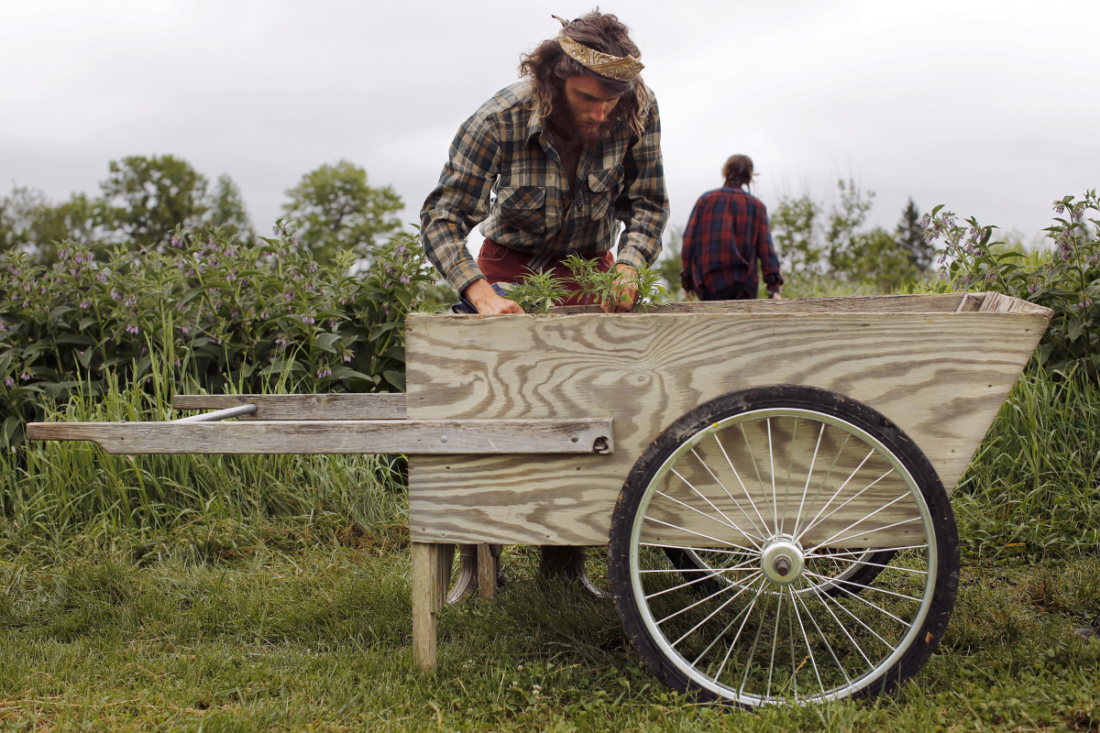
Enforcing this standard meant that last summer, from August through October, Fish and others from the Department of Agriculture, Conservation and Forestry drove all over the state, visiting 31 growers in 14 counties and taking samples from about one in every 10 plants to be processed at the Maine Health and Environmental Testing Laboratory in Augusta. This year, 102 submitted preliminary applications and 80 followed through, paying a $500 fee to become licensed to plant hemp.
“Eventually, if it grows again next year, we will have to hire another person,” Fish said.
AFTER THE HARVEST
After the state’s analysis to determine that the THC is below .3 percent, its role as regulator is over. “Then they are OK to harvest, and we don’t have anything to do with it after that,” Fish said.
Thus the state does not know exactly what happens to this crop. Fish said he surveyed last year’s growers and found that about 60 percent were medical marijuana growers trying out a new plant. He has encountered a few people who told him they were hoping to use the fibers from the plant for other applications. But for the most part, they are growing and harvesting for health and wellness products. Like Ben Rooney.
Rooney made a name for himself, and Wild Folk Farm, by experimenting with growing rice in Maine in 2014. He still grows and sells rice, but as the laws regulating hemp changed, he got curious.
“I like trying new things,” Rooney said. “And no one else was doing it.”
He started to consider its medicinal properties. CBD is sought out for treatment in seizures, for instance, particularly for children with epilepsy. But it wasn’t easy to sell the Wild Folk Farm crop that first year. Some hemp farmers separate the CBD completely from the plant, eliminating the THC. But Wild Folk Farm hemp has a small amount of THC, though below the .3 percent allowed.
“One of our biggest issues initially in getting into places is that stores didn’t want to carry any product with any THC in them,” Rooney said.
Another factor is that retailers are just flat out confused about the law, and it is easy to see why. Martha Carton, who began adding CBD to some of her chocolate-dipped snack bars in January, said she found three or four stores, including Morning Glory in Brunswick, that were happy to carry the CBD bars (which retail for $5.99 each at Morning Glory). Others hesitated, timid of running afoul of laws.
“Some stores are interested,” Carton said. “But they’re like, we don’t know what the regulations are going to be.”
Carton said friends who sell salves and other CBD products online – which is considered interstate commerce and thus subject to federal laws – have had their sites taken down by online platforms such as PayPal.
“I just wish everybody would get on the same page,” she added.
The FDA does target herbalists and medicinal plant producers who promise specific medical benefits – in the government’s eyes, there’s no proof that marijuana or hemp have medicinal effects. But Maine isn’t chasing after makers using CBD in products, not to enforce federal laws nor to demand proof that the CBD came from Maine-grown hemp.
Carton was getting her CBD from a medical supplier in Maine who was bringing it in from Georgia. But she was happy to hear about the sudden boom of hemp farmers in the state.
“I would really like to have somebody who is doing it locally,” Carton said.
And as with the food movement in general, local seems to be a strong selling point. After some bumps in the road, Rooney established connections with two dozen retailers who are happy to stock his locally grown product.
One of them is Nectar of Maine, a superfood smoothie shop in Bridgton that offers CBD as an add-in to its smoothies and sells tinctures, salves and a few edibles like CBD-infused All Kind chocolate bars made in Maine. Store manager Blake Dickson said that Nectar keeps a low, “classy” profile – “we don’t have pot leaves all over the place, or neon lights” – but that Bridgton has been welcoming to the business. “They recognized that CBD was not psychoactive,” Dickson said.
Given the option, he said his customers tend to prefer Maine-grown hemp products. He prefers to work with local growers as well, both to support the local economy and because the prices tend to be better.
“There are a lot of non-local companies out there that are just gouging people,” Dickson said.
For a new hemp farmer like Rooney, it has been important to keep prices low. But not too low; he needs a price point that is economically sustainable and works for his small farm.
“Our niche will have to be artisanal and high quality,” Rooney said. “Whether we are able to stay in the game is the question.”
That’s a sign of how fast the hemp game is changing. Last year, Rooney struggled to find and establish markets. This year, he’s facing a slew of new competitors, though as a “clean” hemp grower, possibly the only certified one who will bring a crop to market, he has an advantage. Next year though, if interest in farming hemp in Maine continues at this pace? An early adopter could be edged right out of this hot market.
